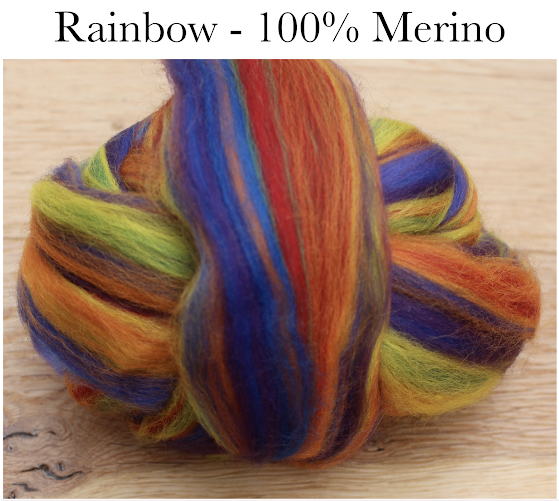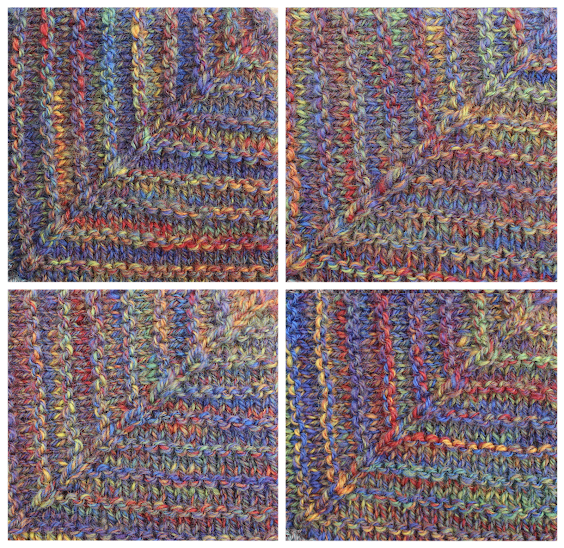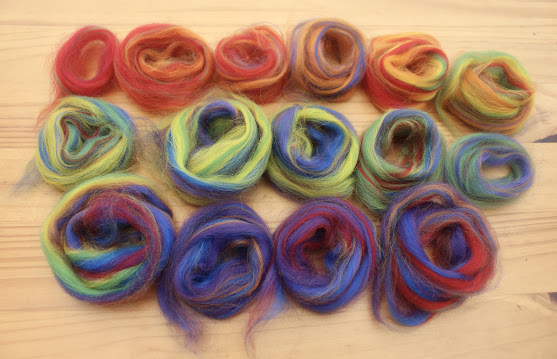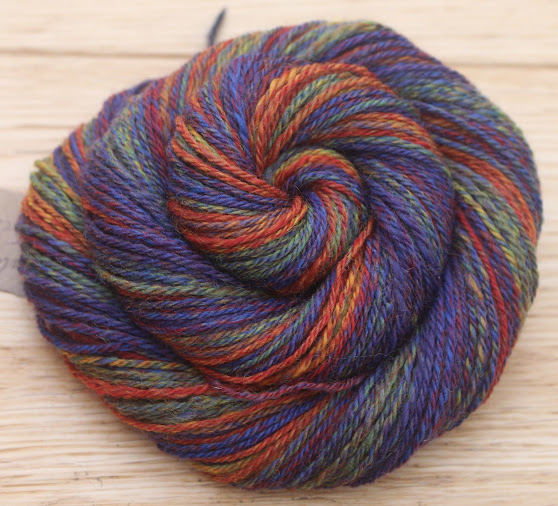This year I’ll be writing a blog series, sharing several different ways of spinning commercially available, multicoloured blended tops. I’ve tried to choose blends that contain colours from more than half of the colour wheel. The kinds of blends that are a little tricky to guess immediately how they’ll spin up.
I’ll be using the word questionable to describe any blend that would cast doubt in the mind of even the most experienced spinner. A blend that would cause you to pause before ordering it and question how it might turn out.
Novice spinners are regularly attracted to the bold, multicoloured stripes of a vertically blended top, but are frequently left disappointed when their beautiful combed top turns to mud on the wheel. In this series, I’ll be sharing several techniques that can help reduce the amount of optical blending during spinning so that some of those original colours still show up in the final yarn. By the end, the blended tops will almost certainly not be questionable.
Rainbow
 |
| Images reproduced by kind permission of World of Wool |
The images above of Rainbow from the World of Wool Website are a very good representation of its true colour. It contains 7 colours, presumably to represent the traditional ROYGBIV rainbow hues.
Here are the colours within Rainbow. The last 3 colours are very similar, making the blue in this blended top quite dominant.
I spun 8g of Rainbow to see how it would look if I allowed the colours to optically blend together. I just drafted it out and then spun it from the tips. I then chain-plied it at the wheel to achieve a 3-ply yarn.
The resulting optically blended colour is quite a dark, neutral brown/grey with flecks of rainbow colours that are only really observed when you look closely. It's quite an attractive grey, that I would happily wear, but there is very little evidence of that original 7 colour rainbow.
I arranged all of the yarns from the blends I’ll be spinning in this series into a kind of muted gradient, and I’ll be spinning them in this order. They have all been spun with no attention paid to colour management, they’ve simply been pre-drafted, spun, and then chain-plied.
 |
| Rainbow fibre that has been drafted and spun from the tips. The singles have then been chain-plied. |
As I progress through them, I’ll be knitting all of the yarns into a mitred square blanket. That’s the plan anyway!
All of the yarns in this series will be spun on my Electric Eel Wheel 6 - This is an affiliate link and if you click through and make a purchase I may receive a small percentage of the purchase price at no additional cost to you. Any income from my blog goes a small way towards funding future blog projects.
Spinning Rainbow 4 Different Ways
Spinning From The Fold
To spin from the fold I always pull off just a little over a staple length of fibre so that I don’t end up with a bunch of short fibres at the end.
When I spin from the fold I like to spread the colours out along my finger so that I can spin them one after the other. However, with this top, I was really struggling to control the order of the colours entering the drafting zone so I split it in half.
This made it significantly easier to maintain control of the fibres and manage the colours entering the drafting zone.
The resulting yarn (as with most blends that are spun from the fold and then chain-plied) is strangely dull from a distance, and quite busy-looking close-up.
It was probably my least favourite of all the Rainbow yarns I spun, but it complemented the other 3 yarns well. There are a lot of optically blended browns and greys in there, which is inevitable when you are literally spinning all the colours of the rainbow.
Splitting into Vertical Strips
Well, after spinning 3 multicoloured blends that were quite well blended, it was a genuine pleasure to be approaching colour management with a less blended top like Rainbow. I was extremely hopeful that my final yarns would look more like the rainbow top and less like the heathered neutral grey that I’d spun originally.
This was one of the easier blended tops to open up and, as it seems to have gone through fewer blending cycles, the bands of colour are quite a bit thicker than some of the other blended tops in this series.
I set about tearing off vertical strips down the length of the top. I was trying to group colours together that wouldn’t combine together to make brown or grey. At the same time, I wasn’t being overly strict about it. A little bit of muddiness will add to the complexity and make for an intriguing spin. I didn’t want a bold yarn made up of just primary and secondary colours, but I didn’t want to spin a neutral yarn either.
When I’d finished dividing the blended top up I arranged the nests in a kind of spectrum order. You can see how intentionally imprecise I’d been when I divided up the colours. I didn’t mind if a little bit of orange crept into the blue, or a little bit of red entered a predominantly green grouping. Hopefully, this will just help to tone the colours down a little.
This method is probably the easiest way of designing your own yarns from a blended top as you are able to determine the order of the colour sections and how long you want them to be. As I’m only going to be knitting mitred squares with my yarn, I want the colours sections to be quite short. I broke all of my nests in half to give me a colour repeat within the yarn.
I’ll be spinning them in this order as I don’t want my yarn to be too busy.
Here's the final chain-plied yarn spun from vertical strips. I love how simply breaking the blended top into smaller sections allows most of the rainbow colours to show up in the final yarn
This was probably my favourite yarn spun from Rainbow. It was easy to prepare and allowed me to decide just how long I wanted my colour sections to be. If I were to spin Rainbow again, this is the preparation that I would choose.
Making Blending Board Pencil Roving From a Single Length of the Board
I discovered this technique while I was writing my 'Spinning into Focus' blog series. It's a really quick and effective way of spinning blended top from the side rather than the end, so you're spinning from a reduced number of colours. There will still be a little bit of muddiness in this final yarn as the colours will fall were they land on the blending board, rather than me taking control of their positions in the yarn.
As Rainbow is quite a wide top comprised of 7 different colours, I broke off just a single length of top to fit across my entire blending board. I then spent a few minutes opening the top up, trying to get the colours to sit next to each other rather than on top of one another.
Once I was happy that I’d spread the colours out across my board, I brushed it all down in a single layer…
… and then rolled the whole lot off as one big, fat blending board rolag.
As spinning from thick rolags is not an awful lot of fun, I went on to draft the rolag out quite thinly into a kind of pencil roving. I find that the colours keep a lot more separated this way too.
You can see that this method reduces down the number of colours along the width of the roving but as I didn’t control the colour arrangement, I should get quite a few muddy tones which should hopefully add a complexity to the final yarn.
I wasn't overly keen on the final chain-plied yarn to begin with...
... but once I'd knitted it, I quite liked it, especially seeing it alongside all of the other mitred squares. I wouldn't want a whole sweater in this, but I think it would be very pretty as stranded colorwork against a neutral dark grey background.
Dividing the top up into rainbow order and then dizzing off the blending board
As Rainbow (almost) contains all 7 of Newton’s designated rainbow colours I thought it would be fun to spin a yarn in 7 colour rainbow order. The most enjoyable way I could think of doing this was to diz them off my blending board.
To help guide me on where to place the colours on my blending board, I attached a strip of masking tape to the top of the board. I then marked off and labelled the 7 different colour sections to instruct me on where I needed to place the fibres.
Well, it took me a little over an hour, and it was pretty tedious, but I managed to put all 25g of fibre on my blending board in almost rainbow order. Some of the colours were too thin to separate out so there are quite a few colours in the wrong place on the board, but hopefully this should just help to tone down the brightness of the rainbow.
Here’s a close up of my blending board after I’ve brushed it all down. I love that it’s not all flat colour and those misplaced fibres should add to the complexity of the final yarn.
The last time I dizzed fibre off my blending board I found that it was a pretty reliable way of getting the colours to blend together. However, as the coloured fibres only blend with the neighbouring fibres on either side, I shouldn’t get too much muddiness.
Using the smallest hole in my diz, I moved side to side, gradually working my way up the blending board to give myself a rainbow-coloured pulled top with a short repeating mirrored rainbow pattern.
This close-up image shows that there are almost always two or three different colours along the width of the drafted top. This should result in some nice fluctuations of colour when I chain-ply it.
There was a bit of discussion on the Electric Eel Wheel Facebook group about whether you can spin a true worsted yarn from fibre prepared on a blending board. Well, I think this is as close to a worsted prep that you can get from a blending board. The purist in me would probably still class it as semi-worsted prep though.
The singles in this yarn had the most definite colour repeats…
… and this was the cleanest and freshest of all of the rainbow yarns...
... but I was a little disappointed to find that the repeating mirrored rainbow that I had so carefully placed and drafted off my blending board gave me 4 almost identical mitred squares. Why am I surprised?!
I much preferred the yarn spun from vertical strips of Rainbow top, which was significantly less effort, so no, I won't be trying this again!
Despite a couple of disappointments, I really enjoyed spinning Rainbow as the colours were much more defined than any of the World of Wool blends that I had spun previously. It was a joy to see 4 very different yarns, knowing that they had all been spun from identical fibre.
I’m not a lover of bright colours, but after spinning Rainbow 5 different ways, I can definitely see me combining the most blended grey/brown yarn with the yarn spun from vertical strips and knitting them both into a mostly neutral sweater with a multicoloured fairisle yoke pattern. I think I need to try that!
If you've found any of this post interesting or useful, please pin this image to Pinterest. It makes a big difference to me and helps other spinners find it too.
At this point, I normally suggest similar related blog posts, however, my list of spinning-related content is becoming a little unmanageable... If you'd like to read more blog posts about spinning and fibre preparation, please take a look at this page here where you will find links to all of my spinning and fibre articles.
Thank you for reading, and happy spinning!
Other blog posts in this series
 |
| Questionable Blend #2 Over the Rainbow |
----------
Please be sweet and share the love. Leave a comment, subscribe to my YouTube channel, like my Facebook page for regular updates or follow me on Pinterest, Bloglovin' or Instagram














































No comments:
Post a Comment